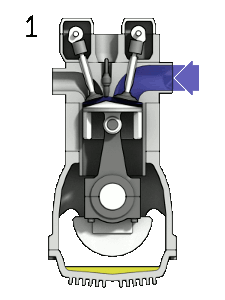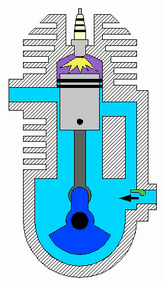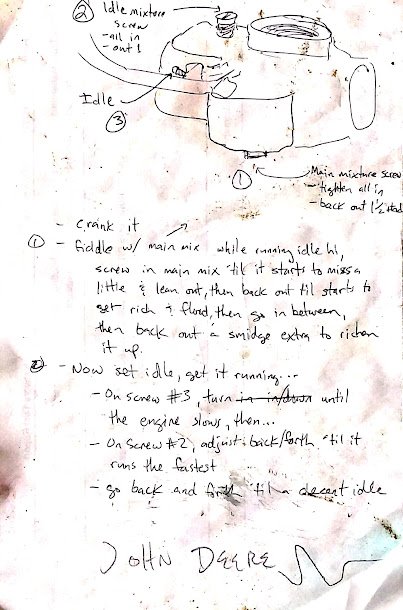I've got to fix my stinking old lawnmower today. At least, that's the goal.
Yesterday, when it wouldn't start, then kinda did, then just flat out didn't, it got me mad-sad and frustrated.
A broke down lawnmower makes you think.

Books
There are some books that you can't get out of your head. For me, one such book is Zen and the Art of Motorcycle Maintenance by Robert Pirsig. This is undoubtedly true, because I think I've referenced this book once, no, twice before on Hive, and I'm doing it again. Like a mole, it just comes back to the surface for me to whack.
Just now, after time-capsuling back to the first "Zen" post, I realize I thought about and wrote about it in the "once' post for the same reason as now...a hard-headed lawnmower. I did a mini book-review in that "once" post and connected it with Hive a bit...you can see it in the section called "Two things from Zen to share with Hive."
For now, the thing I liked most about the book was its emphasis on systematic, logical thought. How repairing a motorcycle, or a lawnmower, is a series of cause-and-effect logical tests. When chained together, they yield the result of a fixed machine.
But, and this is where the books is a little out there, Pirsig writes a lot about philosophy and of what he calls the "quality moment," which I interpret as your gut feeling, your instinct, your hunch or intuition that has absolutely nothing to do with logic or systems or cause-and-effect. But, it's that moment where, after disassembling half the engine, you just go, "Hmmph, damn thing might just be outta gas."
Engines
Today, I'll be thinking systematically and logically, I hope. I hope to also use some intuition and apply it correctly. The goal is to combine these two opposite skills and get on my lawnmower and ride!
Internal combustion engines are four letter words nowadays. We ride and fly in things powered by them and attend conventions to say they're killing the environment. Then we ride them home.
Still, they're pretty fascinating to me. Several years ago I got somewhat geeky on the difference between a 4-stroke and 2-cycle engine. Here's the upshot:
A 4-stroke is what your car has. It comes from the "Otto cycle", developed by Mr. Otto, a German fellow back in the 1800s, I think. There are four strokes, or cycles:
- intake
- compression
- power
- exhaust
Intake sucks in gas and air, compression pushes that air and gas down close and gets it ready inside the engine's cylinder, add a spark and an explosion booms! for power and pushes the piston forcefully back which turns a rotary shaft for kinetic energy, and exhaust poofs out the cruddy smoke so that clean gas and air can come back inside. This happens scores of times per second. It depends on the RPMs you're running at, but it's maybe 10 explosions/second when idling your car or 40 when revving it up. Pretty amazing to me that things exploding 10 to 40 times per second don't fly apart more often.

The awesome animation above shows the four cycles. Watching the intake and exhaust valves open and close, you can see gas/air going in, exhaust going out, and the piston turning the crankshaft.
A 2-stroke engine is smaller, louder, dirtier, but more powerful. I've grown to love economics and see it more and more each day in "real life." We think of economics as theoretical bologna in a classroom. It's not. It's what we do every single day. Mostly, it's about decisions and tradeoffs. 4-cycle and 2-cycle engines offer a tradeoff between a quiet and clean 4-cycle, versus a loud, dirty, small yet powerful 2-cycle.
2-cycles engines are the ones where you mix the gas and oil. They're weed whackers, chainsaws, snow throwers, outboard motors, and such. They're small, but they pack a punch. Really, all four cycles are still there, it's just that the engine does two cycles together in one swoop. Two of the cycles occur at the same time, rather than one at a time. The big difference is with a 4-cycle only one valve is open at a time...hence it's more "contained." With a 2-cycle the intake and exhaust and kind of both open for a slight moment simultaneously during each revolution...means it's messy and loud. But, you get a power stroke every revolution. Maybe you can see it in the animation below.

It doesn't matter here. The short story is that (a) you get twice as many power strokes than a 4-cycle for the tradeoff of (b) it's messier and noisier. This is why outboard motors on a boat leave a small sheen of multi-colored oil on top of the water (the exhaust scavenges the cylinder and grabs some unburnt fuel/oil and spits it out into the water for it to rise to the surface, like a mole to get whacked). This is also why the teenage knucklehead who zooms through your neighborhood on a weed whacker-powered-skateboard is both really loud and really smokey as he passes. But he's fast.
Machine thinking
When your lawnmower won't run, you've got a problem. Psychologists say there are three approaches to problem solving:
- trial and error - might work, maybe
- an algorithm - a systematic, logical approach that will work, but might take some time
- a heuristic - this is kind of using your brain, common sense, or just what's worked before in a similar situation
I've heard of machine learning, but I'm not sure what it is. Something related to artificial intelligence. I've read by those in the know that these two aren't the same thing. I should look up the difference right now, but I don't want to. I want to finish writing this instead. I'll stay ignorant on machine learning vs. AI for now.
And besides, machine learning is not what I'm writing about. I'm writing about machine thinking.
To fix a machine, you've got to think like a machine. My DNA is mostly hard-wired to follow problem solving technique #2 above, algorithm...a process.
Machines, or internal combustion engines anyway, are amazingly complex. But, they're also amazingly simple. They come down to fuel, air, spark...Boom!
It's really just blowing stuff up, but then, somehow changing that blow-up energy into something useful like a wheel turning.
There are three systems to investigate when there's an engine problem. And this is where the Zen book comes in, systematic, methodical, logical thinking helps:
- compression
- ignition
- transmission
Compression is all about the physical engine itself, whether the piston fits snugly inside the cylinder. With good compression, the engine makes a woof! woof! woof! sound as it puffs air through itself. This is also why it's hard to pull a rope to start a lawnmower sometimes. Compression is good. If no compression, tie a rope to your engine and use it as a boat anchor, it's toast.
Skip ignition for now and go to transmission, this is turning that explosion into rotary motion. In your car, the crankshaft (driven by the pistons) rotates. The crankshaft turns the driveshaft (just a spinning rod) to turn the wheels. The boom! has been transmitted into wheels turning. Simple in concept, tricky mechanics with lots of gears.
With a small engine like a lawnmower, the problem is usually in ignition...the thing won't fire.
Again, more systematic thinking here. I just wrote that engines are simply about fuel, air, spark, and boom! Ignition problems come down to either:
- it's gettin' no gas
- it's gettin' no air
- it's got no spark
If you've got gasoline and oxygen, and throw a spark, it'll ignite. If not, one of the three isn't there.
I've been through all three of these problems more than once. Yet again, systematic, methodical thinking...
- Is it getting fuel?
- Is the air filter clogged?
- Check spark plug for sparks. How? Take it out, plug the electrical wire onto the top, hold the bottom to the frame of the engine, try to start it by pulling the rope or turn the key while watching the spark plug gap. If good, you'll see sparks. (Still, it might not be good. I've been fooled by a half-way weak plug.)
Usually, small engine problems are in the carburetor...the mix of gas and air is wrong. I have no doubt this is my problem...it's not getting gas. How do you know? you might ask.
Systematic thinking. I did a test yesterday.
I pulled out the spark plug, sprayed some carb cleaner (highly flammable) into the cylinder where the spark plug normally sits, replaced the plug, turned the key. Yep, it fired off just fine. It ran for a second, then sputtered out. I did it a few times. Same result. Tried to put it onto full choke (cut off the air) to force it suck in gasoline. Nope, it's not getting gas.
It's either a clogged fuel line, or more likely, clogged tiny injector points in the carburetor. This is fixable, just requires taking apart, cleaning, and putting back together.
My fear is fiddling with the carb though. There are three adjustments on it: air, fuel, and who knows the what the third goes to? Do you know how many possible configurations 3 adjustable screw-things can generate? A doggone lot is the answer. I futzed with it a few years ago for days before getting it to run right. I drew an illustration, with instructions, in case I needed to do the same thing again. Of course, I can't find it now.
I was able to dig up an archived digital scan, though, Woo! Hoo! :)

Conclusion
My lawnmower is not getting gas. I need to get gas to the carb.
A fear of possible stupidity hit me yesterday evening after all of my systematic, methodical, logical thinking. My wife asked, "Is the gas tank empty?"
Intuition.
I'll post follow-up results in the comments.

Not on Hive? The top benefits of the Hive blockchain: (1) no ONE person/group runs it, (2) YOU own and control your content, and (3) YOU earn the rewards that your content generates. Learn more or consider using my referral link to get your free account here and I'll support you as you begin. Alternately, you can see other options here.

